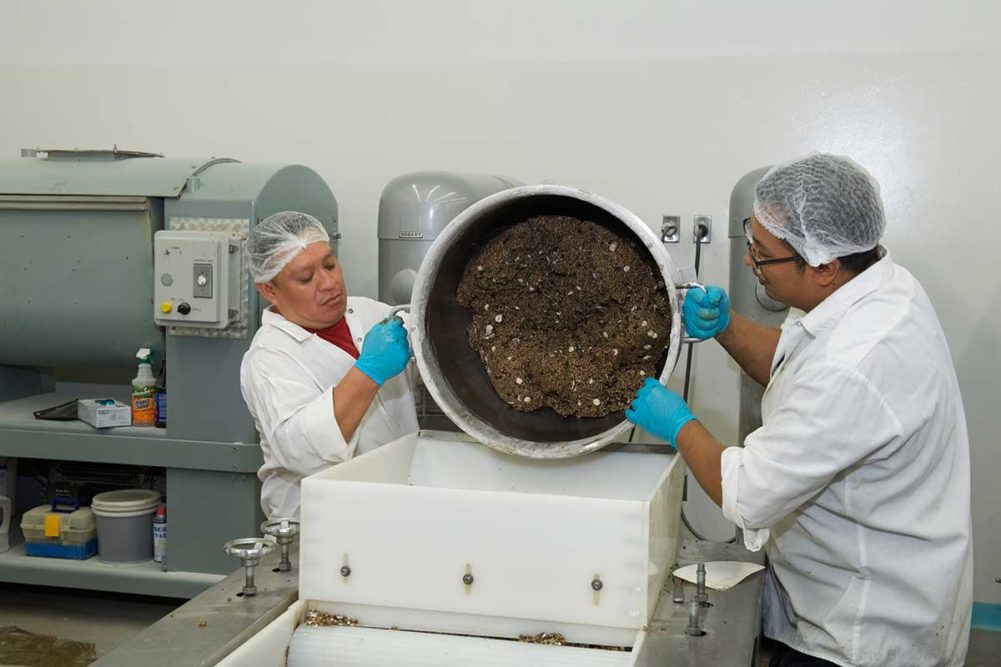Walk into Nettie’s Kitchen, the manufacturing arm of Jimmy! Functional Snacks, Chicago, and the first thing one notices is the comforting aroma of peanuts and chocolate. With such an emphasis on protein, fat and health, nut butters and chocolate permeate the entire facility. Production runs in two shifts Monday through Friday with Saturdays for sanitation, maintenance and any overflow production.
Ingredients and packaging delivered from the warehouse are stored on one side of the building while production happens on the opposite side. Ingredients are manually weighed and scaled into batches and put on racks with liquids and dries separated. Two 80-quart Hobart mixers produce 45-lb batches of bar dough in three minutes. The dough is manually transferred from the mixing bowls into the roll line’s hopper. Two rollers smooth out the dough and create the slab of bar dough. The first part of the slab is sliced off and added back to the hopper as rework and then a cutter automatically slices the dough slab into the appropriate-sized bars according to weight.
Bars are then placed on pans and racked for cooling. Removing the bars and placing them on the pan is one of the most arduous jobs on the production room floor. Not only will the cooling tunnel relieve a person to do more valuable work, but it will also cut the cooling time on the bars from one day to 7 to 10 minutes.
During Baking & Snack’s visit, the space was filled with racks and pans, eliminating valuable production space and producing a lot of washing for employees. Annette Del Prete, president of Nettie’s Kitchen, described it as a huge bottleneck for production.
“Automating this production line will be life- and company-changing for us,” she said. “The way we run the plant will be different. What employees do will be different.”
Once bars are set — none of the bars are baked, so “cooling” is more of a setting process — two employees decorate the bars with their toppings, whether chocolate drizzle or crumble. Nettie’s Kitchen has invested in an automated drizzler from MK Machinery to keep up with throughput once the cooling tunnel is installed. Ms. Del Prete admitted that, despite needing the automated drizzler to streamline production and keep up, she would miss the variation hand-drizzling provides.
“It was important to me that we made our bars beautiful because we eat with our eyes first,” Ms. Del Prete said. “If you’re eating a cookies and cream bar, you want to see it.”
When the topping has set, bars are manually fed into two Barrington flowwrappers. Metal detectors scan each bar for any food safety issues, and then they are sent by conveyor to packaging.
“Our main critical control point is our metal detector,” explained Kevin DeLozier, SQF practitioner and supply chain manager. “We don’t need a kill step because all of our raw material has already had one, so there’s no baking. It’s all done at ambient, and all our ingredients are shelf stable.”
The plant is SQF Level 2 certified with GMPs in place, and bars are tested weekly for listeria, mold, lead and water activity. Mr. DeLozier, Kyle Lasser, production manager, and Ms. Del Prete also have been trained on HAACP. Mr. DeLozier has also implemented standard operating procedures for both production and sanitation.
“We track everything from start to finish, and lot numbers go one step forward to the consumer and one step back to our supplier, so if there’s a recall before us, we can find every product that’s affected and get it back to us,” he explained.
Employees build and pack boxes that are then labeled automatically and sealed. Once the front-end of the line is automated, there are plans to extend the packaging line and feed the flowwrappers with a conveyor.
Even without the automation, the team at Nettie’s Kitchen has been able to improve production from 60 to 120 batches a day. The team estimated that with the automation installed, that rate will triple.
Finished products are then distributed to one of three places, depending on the customer. Some bars are sent to customers’ warehouses for storage and fulfillment, while other customers’ products are stored at one of the company’s offsite warehouses and typically picked up by the customer.
With all the challenges Nettie’s Kitchen has faced on the manufacturing side, Ms. Del Prete and her team feel confident in the lessons they’ve learned and the investments they’ve made. Whether it’s learning a new piece of equipment or developing a new product, Jimmy! Functional Snacks isn’t afraid to try, even if it means getting a little beat up.
“I don’t even call it a fail because you have to keep throwing stuff against the wall to see if it sticks,” she said. “And it makes us better in what we do.”
This article is an excerpt from the December 2022 issue of Baking & Snack. To read the entire feature on Jimmy! Functional Snacks, click here.





